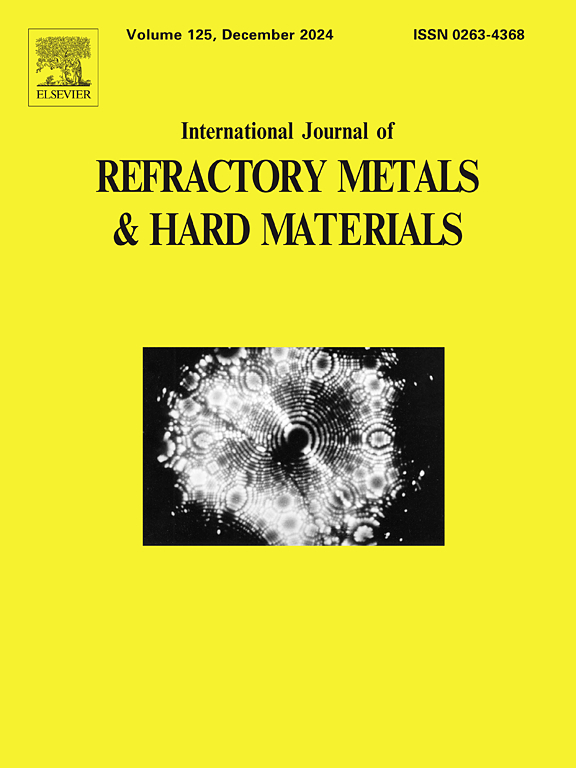Effect of heat treatment and different elements on the phase composition and fracture behavior of Nb-Si-Zr based alloy
IF 4.2
2区 材料科学
Q2 MATERIALS SCIENCE, MULTIDISCIPLINARY
International Journal of Refractory Metals & Hard Materials
Pub Date : 2025-04-29
DOI:10.1016/j.ijrmhm.2025.107211
引用次数: 0
Abstract
In this paper, the effects of 1300 °C/30 h heat treatment on the microstructure and fracture behavior of Nb-16Si-20Zr-xm (xm=0, 4Cr, 2C, 4Hf, 4Ta, 0.5Sc) alloys were studied. Except for Nb-16Si-20Zr-2C alloy, the transformation from γNb5Si3 phase to αNb5Si3 phase occurs in other Nb-Si-Zr based alloys after heat treatment. There is a small amount of ZrC phase exists in the Nb-16Si-20Zr-2C alloy. After heat treatment, the segregation in the alloys decrease. In addition, the different phases are spheroidized and coarsened but the phases in Nb-16Si-20Zr-0.5Sc alloy are refine during the heat treatment. Except for Nb-16Si-20Zr and Nb-16Si-20Zr-2C, the room temperature fracture toughness of other Nb-Si-Zr based alloys is improved after heat treatment, which is related to the tetragonal crystal structure of αNb5Si3 phase and the spheroidization of the phase. Nb-16Si-20Zr-2C(HT) alloy has the highest fracture toughness mainly because of the precipitation strengthening of ZrC phase. There are many crack deflections and microcracks in the crack path of Nb-16Si-20Zr-2C(HT), and its fracture surface is not flat.
热处理及不同元素对Nb-Si-Zr基合金相组成及断裂行为的影响
本文研究了1300℃/30 h热处理对Nb-16Si-20Zr-xm (xm= 0,4cr, 2C, 4Hf, 4Ta, 0.5Sc)合金显微组织和断裂行为的影响。除Nb-16Si-20Zr-2C合金外,其他Nb-Si-Zr合金热处理后均发生γNb5Si3相向αNb5Si3相的转变。Nb-16Si-20Zr-2C合金中存在少量的ZrC相。热处理后,合金中的偏析减少。此外,Nb-16Si-20Zr-0.5Sc合金在热处理过程中,各相发生球化和粗化,而各相则发生细化。除Nb-16Si-20Zr和Nb-16Si-20Zr- 2c外,其他Nb-Si-Zr基合金热处理后的室温断裂韧性均有提高,这与αNb5Si3相的四方晶结构和相的球化有关。Nb-16Si-20Zr-2C(HT)合金具有最高的断裂韧性,主要是由于ZrC相的析出强化。Nb-16Si-20Zr-2C(HT)裂纹路径中存在较多的裂纹偏转和微裂纹,断口不平整。
本文章由计算机程序翻译,如有差异,请以英文原文为准。
求助全文
约1分钟内获得全文
求助全文
来源期刊
CiteScore
7.00
自引率
13.90%
发文量
236
审稿时长
35 days
期刊介绍:
The International Journal of Refractory Metals and Hard Materials (IJRMHM) publishes original research articles concerned with all aspects of refractory metals and hard materials. Refractory metals are defined as metals with melting points higher than 1800 °C. These are tungsten, molybdenum, chromium, tantalum, niobium, hafnium, and rhenium, as well as many compounds and alloys based thereupon. Hard materials that are included in the scope of this journal are defined as materials with hardness values higher than 1000 kg/mm2, primarily intended for applications as manufacturing tools or wear resistant components in mechanical systems. Thus they encompass carbides, nitrides and borides of metals, and related compounds. A special focus of this journal is put on the family of hardmetals, which is also known as cemented tungsten carbide, and cermets which are based on titanium carbide and carbonitrides with or without a metal binder. Ceramics and superhard materials including diamond and cubic boron nitride may also be accepted provided the subject material is presented as hard materials as defined above.

 求助内容:
求助内容: 应助结果提醒方式:
应助结果提醒方式:


